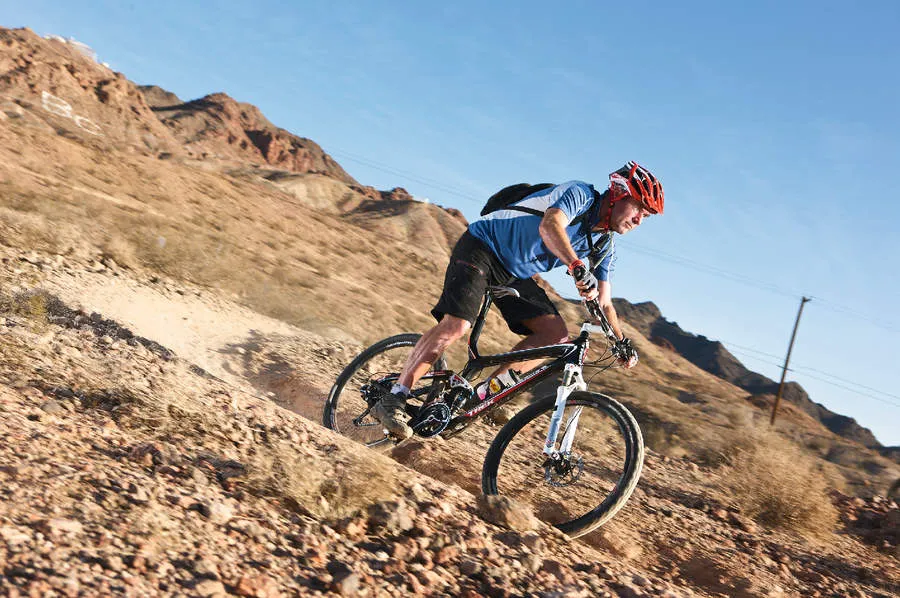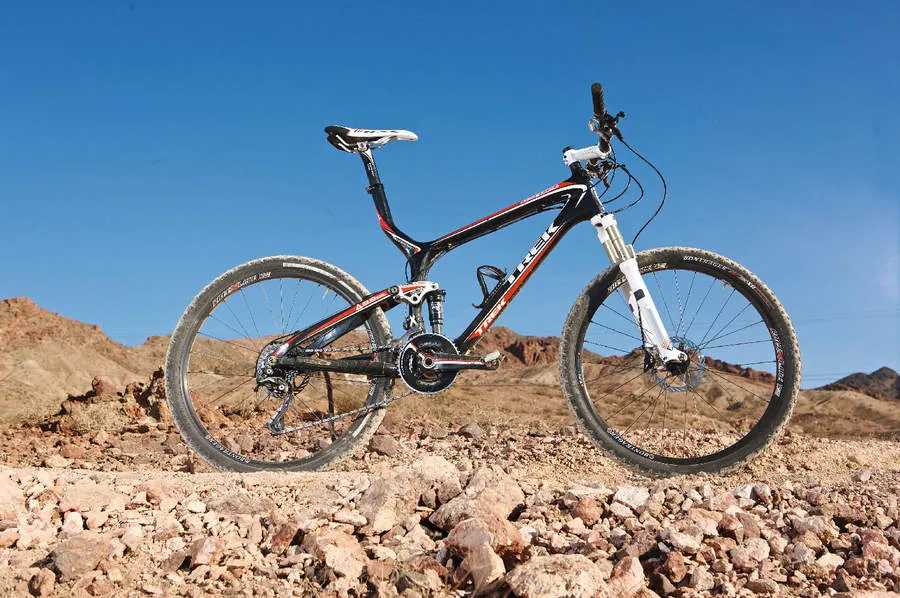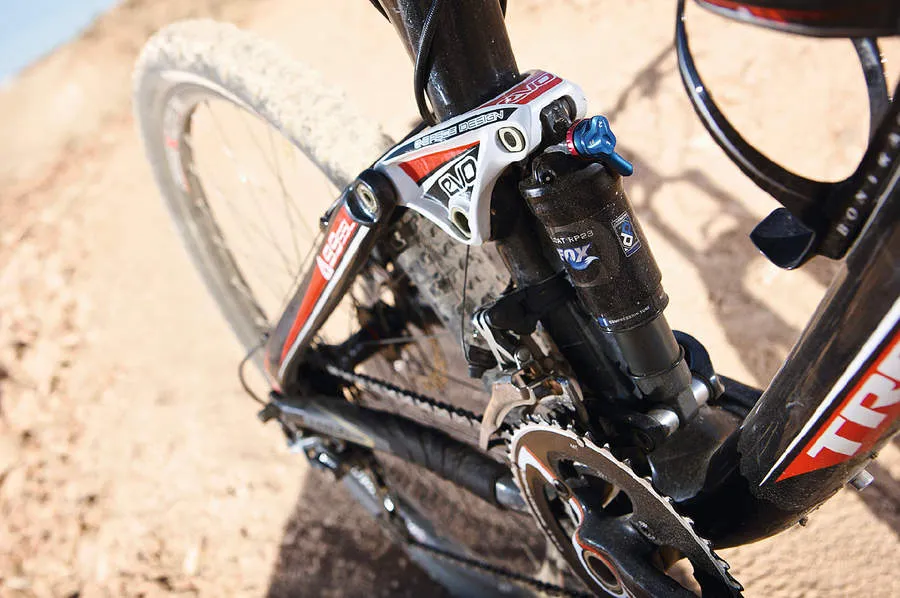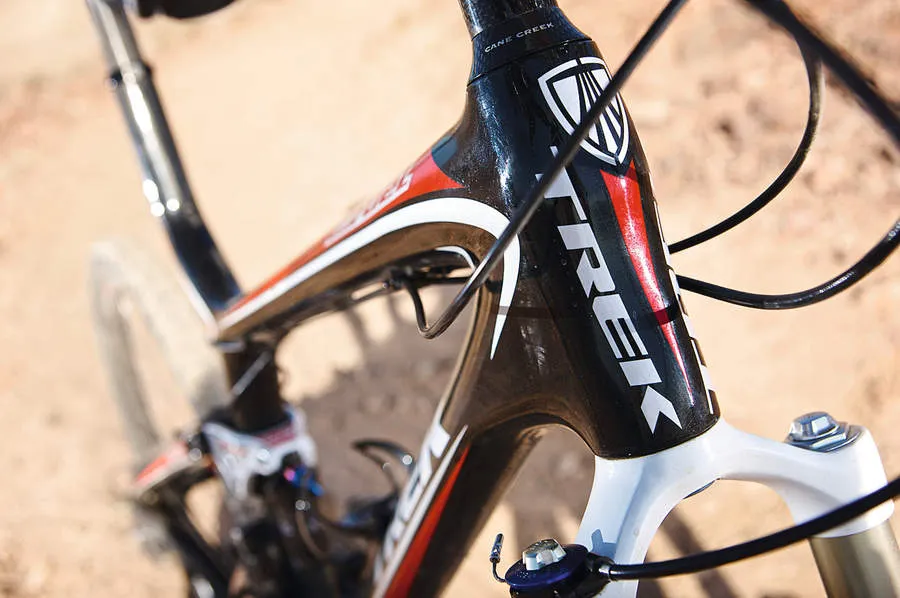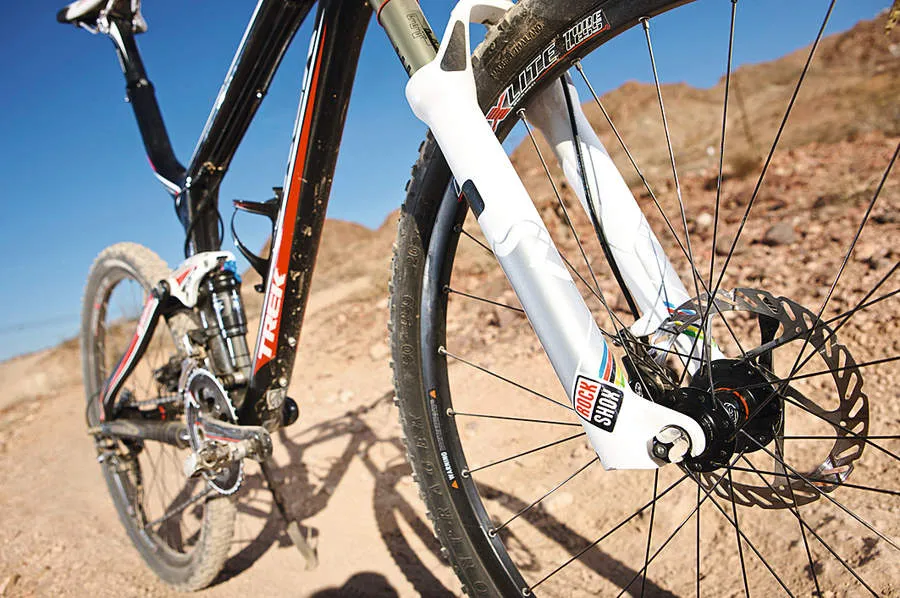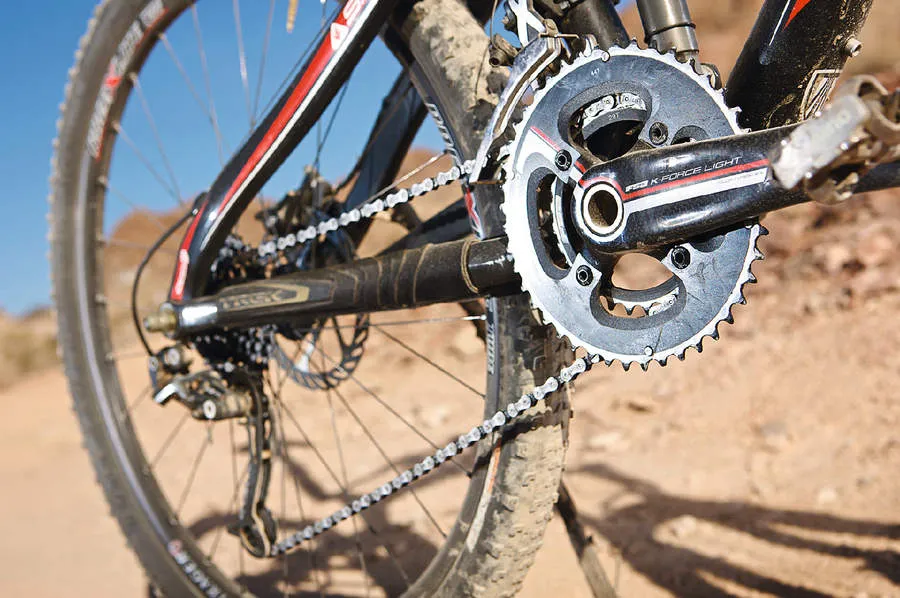Completely new for 2009, the Trek Top Fuel 9.9 SSL is a full-suspension race weapon with a sprinkling of trail bike manners that make it more fun than any 22lb race bike has a right to be.
This is the top model in a six-bike range that starts with the £1,700/US$3,300, aluminium-framed, Reba-forked Top Fuel 8 and goes up to £4,500/ US$7,150 for this race-ready SSL World Cup version.
The model that Lance Armstrong rode in his first two comeback races, our test bike tipped the scales at 22.2lb without pedals. Trek’s product managers tell us full production spec bikes (which will be available around the turn of the year) will be trimming a pound or so off that.
Ride & handling: race bike precision, trail bike fun
The essential joy of the Top Fuel 9.9 SSL is that it accelerates and climbs like a race bike, but handles like a slightly longer travel trail bike. It’s certainly a little more nervous in big terrain than its 120mm travel Fuel EX stablemate, but on typical mixed cross-country terrain it’s noticeably faster.
The fork and back end are both well controlled and nicely balanced over even the harshest bumps and the geometry is suitable for taking a more aggressive riding approach than you usually would on a race bike.
Like most superlight race-bred bikes, this Top Fuel feels very nimble, fast in acceleration and a little nervous when you first set off. But a well-balanced riding position and neutral geometry makes it surprisingly relaxed when you start to tackle technically challenging trails.
You soon realise that it’s only the low weight and skimpy tyres that create the initial nervousness, and tyres can be easily changed if you’re not a pure speed freak.
Our test rig came with a Bontrager riser bar too, and we appreciated the extra control of the width and sweep-angle on more technical trails. Production bikes will come with a racier 58cm flat bar, though.
Fast-climbing fans and raceheads will welcome bar-mount lockout levers for the shock and fork but we reckon the Full Floater suspension design and superbly managed straight-tracking fork action creates a ride character that feels completely efficient and doesn’t warrant muffling the suspension action.
The extra traction that comes from leaving the shock and fork open and fully active is a real plus, and pedal forces don’t appear to interfere with the suspension, even when standing up and powering up short, sharp climbs.
On a bike with only 100mm of suspension travel, it’s really hard to say whether the Active Braking Pivot back end is a real benefit. It’s a more obvious benefit on longer travel Treks and the Gary Fisher Roscoe, but it’s not a downside, and Trek changed the ABP setup on the Top Fuel to make wheel removal simple.
Fast, rocky descents are the only time you might wish for more travel, but no bike can offer the best of everything, and the Top Fuel is more fun than any 22lb race bike has a right to be.
Frame: all-new, weight-tuned carbon marvel
The 2009 Top Fuel is totally different to the 2008 model. The Cross Bow OCLV (Optimum Compaction Low Void) frame design incorporates the most sensible ‘seat mast’ setup we’ve seen, extending the seat tube up to a point where you can fit a short, lightweight post with 100mm height adjustability to suit most riders.
Trek says that the Cross Bow construction, incorporating a new magnesium suspension rocker, net-moulded BB90 bottom bracket and tapered (1.125in upper/1.5in lower) head tube, increases stiffness by a mighty 33 per cent and reduces the weight by 100g over the 2008 Top Fuel. The new frame layout also increases suspension travel by 10mm to 100mm.
The carbon-bodied DT rear shock and Trek’s unique ABP (Active Braking Pivot) axle-centred swingarm pivot and Full Floater shock rocker setup do a superb job of controlling the rearguard action under all conditions.
So what’s all this about net-moulding and BB90? Net-moulding is the technique Trek uses to ensure absolute push-fit bearing accuracy in the headset, bottom bracket and swingarm/rocker pivots. The bearing races are carbon rings bonded into the frame structure, and the bearing units are simply pushed in, doing away with cups and threads. This has allowed Trek to create a 90mm width (BB90) bottom bracket shell for a narrower pedal-to-pedal width on a two-ring crankset. Trek says racers requested this – the narrower crank is closer to the spacing of the cranks on road bikes, so there’s less difference between training and racing.
The all-carbon Top Fuel combines generous standover clearance and space for a water bottle. You can choose your seat post length but the 34mm post diameter limits replacement options and we’re not happy with the clamp bolts on Bontrager’s XXX Lite posts – they need way too much brute force to stop slippage.
The aluminium Top Fuels come with a more conventional seat tube. Both the carbon and aluminium frames avoid the bike bag packing/carriage problems that come with full-height seat mast frames.
Equipment: good, light stuff
Our test bike didn’t quite have the full complement of production kit fitted. Production bikes will be fitted with Shimano XTR titanium brakes (not the Avid Juicy Ultimates fitted to our test bike) while RockShox SID World Cup 100m travel forks perform superb bump-eating duties on trails more suited to longer-travel, bigger-hitting bikes.
The drivetrain mixes XTR shifters and gear mechs with a custom two-ringed (42/29) FSA Force Lite crankset. Bonty’s Jones XR Team 2in tubeless-ready tyres have minimal tread, which won’t suit everyone, and certainly won’t suit muddy conditions, but the rest of the finishing kit is good, lightweight stuff that could be changed at point of purchase if you prefer something else.
Conclusion: cross-country limit tester
I’ve tested a lot of heavy-duty, and long-travel bikes, and really appreciate the way you can thunder through rough terrain on them. But my nerve doesn’t allow me to come close to the limits of those bikes, so I still prefer to opt for the advantage of less weight on the climbs. This is a 22lb bike that lets me ride close to the limits of my nerve just before I reach the limits of the bike.
We asked Trek’s global brand manager Michael Browne about the Top Fuel…
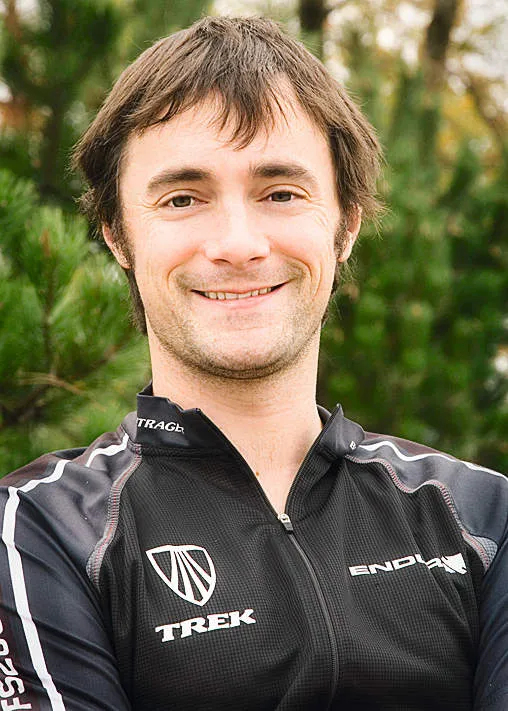
Why would someone choose a Top Fuel rather than a Fuel EX?
The Top Fuel is a pure-bred racing machine, while the Fuel EX has more relaxed angles that favour trail conditions. The EX carbon is a bike for someone who wants an all-round bike and likes to race every once in a while, whereas the Top Fuel’s highest priority is and-and-out racing.
Will Liam Killeen be racing on a Top Fuel now or could he still opt for a hardtail?
Liam will have the option to race the hardtail, but we’re confident he will choose the Top Fuel more often than not.
Why would any rider choose to ride a hardtail over the Top Fuel?
There are still racecourses that have little technical challenge. For those, a rider may choose our Elite 9.9 hardtail. But the Top Fuel is one of a few race bikes where the suspension actually adds a performance advantage. Most XC race bikes’ suspension exist for comfort reasons. The Top Fuel’s suspension platform is designed to give its rider a real technical performance advantage to go faster over rough terrain. ABP and Full Floater tuned suspension make this the reality.
Are there any new developments in the pipeline?
We were quite happy with the surprise impact that the Top Fuel had on the world. The key thing with future developments in our line is that we’re constantly exploring technologies that make sense across the board. Stories like ABP, Full Floater, EVO Link, E2, BB90 all make sense in many applications. We plan to lever those developments in new categories wherever they make sense. 2008 was great for us. 2009 blew some minds. In 2010, expect it again.

